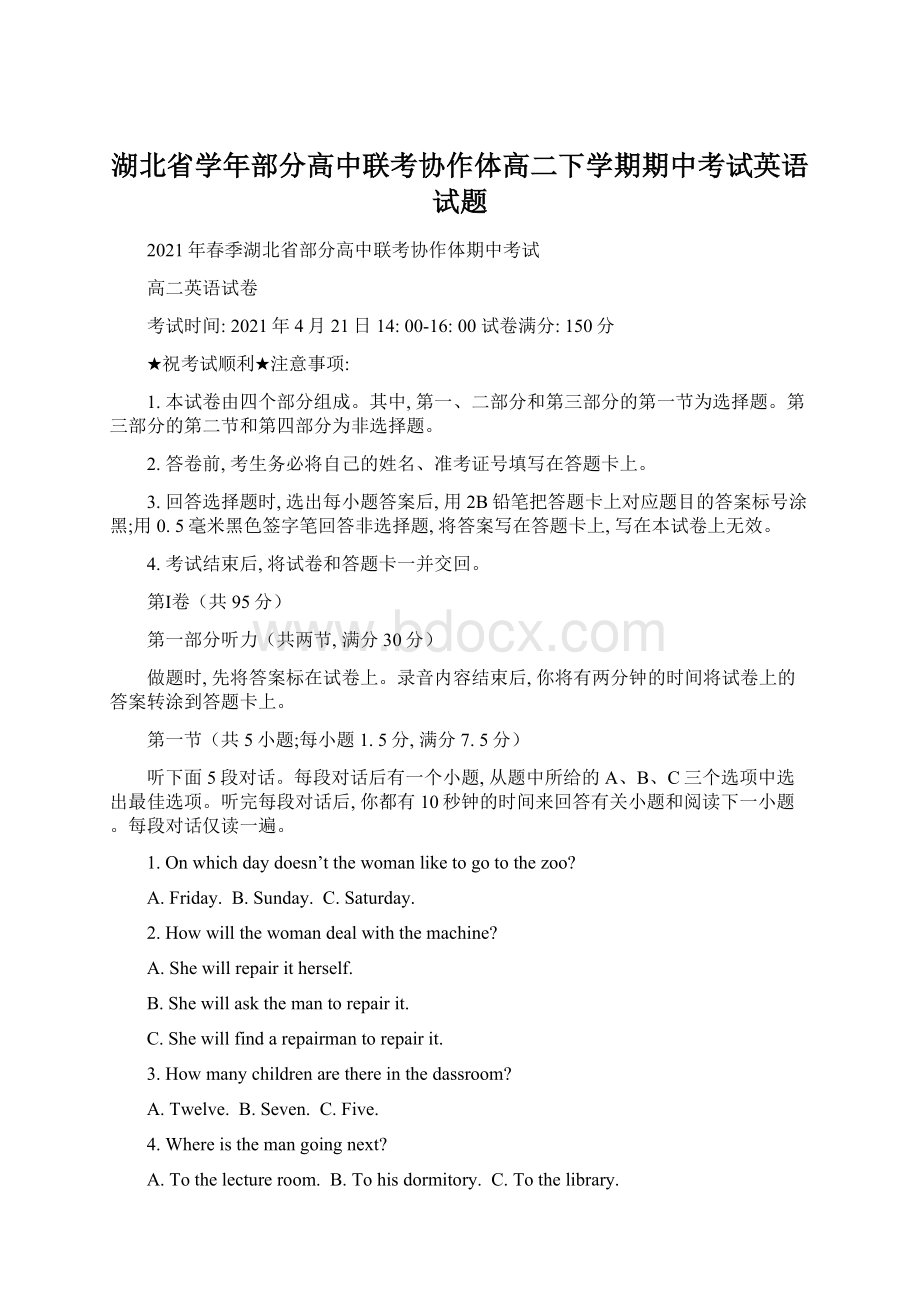湖北省学年部分高中联考协作体高二下学期期中考试英语试题Word文件下载.docx
《湖北省学年部分高中联考协作体高二下学期期中考试英语试题Word文件下载.docx》由会员分享,可在线阅读,更多相关《湖北省学年部分高中联考协作体高二下学期期中考试英语试题Word文件下载.docx(20页珍藏版)》请在冰豆网上搜索。

2.答卷前,考生务必将自己的姓名、准考证号填写在答题卡上。
3.回答选择题时,选出每小题答案后,用2B铅笔把答题卡上对应题目的答案标号涂黑;
用0.5毫米黑色签字笔回答非选择题,将答案写在答题卡上,写在本试卷上无效。
4.考试结束后,将试卷和答题卡一并交回。
第Ⅰ卷(共95分)
第一部分听力(共两节,满分30分)
做题时,先将答案标在试卷上。
录音内容结束后,你将有两分钟的时间将试卷上的答案转涂到答题卡上。
第一节(共5小题;
每小题1.5分,满分7.5分)
听下面5段对话。
每段对话后有一个小题,从题中所给的A、B、C三个选项中选出最佳选项。
听完每段对话后,你都有10秒钟的时间来回答有关小题和阅读下一小题。
每段对话仅读一遍。
1.Onwhichdaydoesn’tthewomanliketogotothezoo?
A.Friday.B.Sunday.C.Saturday.
2.Howwillthewomandealwiththemachine?
A.Shewillrepairitherself.
B.Shewillaskthemantorepairit.
C.Shewillfindarepairmantorepairit.
3.Howmanychildrenarethereinthedassroom?
A.Twelve.B.Seven.C.Five.
4.Whereisthemangoingnext?
A.Tothelectureroom.B.Tohisdormitory.C.Tothelibrary.
5.Whatwillthemanhavetodo?
A.Changeforanewroom.B.Comebackearlier.C.Painttheroom.
第二节(共15小题;
每小题1.5分,满分22.5分)
听下面5段对话或独白。
每段对话或独白后有几个小题,从题中所给的A、B、C三个选项中选出最佳选项。
听每段对话或独白前,你将有时间阅读各个小题,每小题5秒钟;
听完后,各小题将给出5秒钟的作答时间。
每段对话或独白读两遍。
听第6段材料,回答第6、7题。
6.Whathurttheman’sfinger?
A.Apieceofglass.B.Apieceofpaper.C.Asharpknife.
7.Whatdoesthewomanadvisethemantodo?
A.Putabandageonhiscut.B.Gotoseeadoctor.C.Leavethecutalone.
听第7段材料,回答第8、9题。
8.Whydoesthewomanapplyforthisjob?
A.Togainmoreexperience.B.Tohavebetterfuturedevelopment.C.Tomakemorefriends.
9.Whatdoesthemanthinkdeterminesthewoman’sfuturedevelopment?
A.HerageB.Herexperience.C.Herperformance.
听第8段材料,回答第10至12题。
10.Whatdoweknowaboutthewoman?
A.shelikestakingbusesforshortjourneys.
B.Shedoesn’tliketakingbusesatall.
C.Shethinkstaxisareconvenient.
11.WhatdoesthewomanthinkisthebestwaylotravelinLondon?
A.Bybus.B.Byunderground.C.Bytaxi.
12.Whatarethespeakerstalkingabout?
A.LifeinLondonB.TravelinginBritain.C.ThetrafficofLondon.
听第9段材料,回答第13至16题。
13.WherewasGeorgeyesterday?
A.AttheTownHall.B.Athome.C.Inthenewspaperoffice.
14.WhosebabydidGeorgetakecareof?
A.George’ssister’s.B.George’s.C.Jessie’s.
15.Whichofthefollowingdidn’tGeorgedoyesterday?
A.Repairing.B.Washing.C.Shopping.
16.WhydidthewomanwanttospeaktoGeorgeyesterday?
A.Toaskhimtohelpher.B.Toaskhimtoaconcert.C.Toinvitehimtodinner.
听第10段材料,回答第17至20题。
17.Wheredidtheaccidenthappen?
A.Infrontofahospital.B.Nearthetopofahill.C.Atastation.
18.Whatwasthecauseoftheaccident?
A.Highspeedandwetroad.B.Thedriverwassleepy.C.Toomuchtrafficontheroad.
19.WhocalledtheFirstAidCenterforhelp?
A.Apoliceman.B.Ayoungwoman.C.Thespeaker.
20.Whatdidthepolicemando?
A.Hesentthedrivertohospital.
B.Hetookthedriveroutofhiscar.
C.Hequestionedthespeakercarefully.
第二部分阅读理解(共两节,满分50分)
第一节(共15小题;
每小题2.5分,满分37.5分)
阅读下列短文,从每题所给的A、B、C和D四个选项中,选出最佳选项。
A
Smith,Williams,BrownarecommonsurnamesthatyouwillmeetinBritain.However,youmaycomeacrosssomestrangeEnglishsurnames.Thefollowingsurnamesarerare,buttheyarereal.
Gotobed
Youarenotgoingtomeetmanypeoplewiththesurname“Go-to-bed”.ThefirstrecordedpersontohavethissurnamewasJohnGotobeddeofCambridgein1269.ProfessorReaney,anauthorityonEnglishsurnames,explainsthesurnameoriginatedfrompeoplewhohadabed,whichwasrarebackinthe12thcentury.Peoplewereproudthattheycouldaffordtohaveabed,thusaddingittotheirname.Strangebuttrue!
Onions
Thissurname,whichwasfirstpopularinFranceandIrelandbeforecomingovertotheUK,datesbacktol279andidentified(显示)aperson’sjob.Hewaseitheraselleroragrowerofthevegetable.
Nutter
NuttermeansacrazyorsillypersoninspokenEnglish.Youwouldn’tusuallycallyourselfanutter,butit’sgenuinelyasurnamethatoriginatesfromYorkshireandLancashire.It’savariationoftheoldEnglishsurnames“Notere”,whichmeansaclerk,and“Nothard”,whichmeansapersonthatkeepsoxen.
Hardmeat
mighthaveguessedthat“Hardmeat”musthavesomethingtodowithafamilyofbutchers.Infact,itmightjusthavebeenamisspellingofthevillagethatthenamecamefrom,whichwas“Hardmead”inEngland.Wishtheyhadaspellcheckerbackthen!
()21.Whichofthefollowingsurnamescantellafamily’swealth?
A.Nutter.B.Onions.C.Gotobed.D.Hardmeat.
()22.WhatdoOnionsandNutterhaveincommon?
A.TheyoriginatedintheUK.B.Theymeansillypeople.
C.Theydatefromthel3thcentury.D.Theyshowthejobs.
()23.WheredoesthesurnameofHardmeatcomefrom?
A.Anincorrectly-speltvillagename.
B.Aplacefamousforhardmeat.
C.Avillagewithoutaspellchecker.
D.Afamilyofbutchers.
B
The2020NobelPrizeinliteraturehasbeenawardedtoformerU.S.PoetLaureate(桂冠诗人)LouiseGluck.Theprizecommitteestressed“herunmistakablepoeticvoicethatwithplainbeautymakesindividualexistenceuniversal”.GluckisthefirstAmericanwomantowintheawardsinceToniMorrisonin1993.Gluck,77,joinsalistofliterarygiantsandpreviousNobelPrizewinners,including,inthiscentury,Canadianshort-storymasterAliceMunro,Chinesemagical-realistMoYan,etc.
Gluck’sworkincludes12collectionsofpoetryandacoupleofvolumesofessaysonliterarywriting.“Allarecharacterizedbystrivingfor(力求)clearness.Childhoodandfamilylife,thecloserelationshipwithfamiliesisathemethathasremainedcentraltoher,”AndersOlsson,thechairmanoftheNobelCommitteeforLiterature,said.“Sheseekstheuniversal,andinthisshetakesinspirationfrommyths(神话)andclassicalthemes,”Olssonadded,citingher2006collectionAverno,whichthecommitteedescribedas“masterly”forits“visionaryinterpretationofthemythofPersephone’sfallintohellinthecaptivity(囚禁)ofHades,thegodofdeath”
GluckisaprofessoratYaleandaresidentofCambridge,andshealsoservedasU.S.PoetLaureatefrom2003to2004andisnostrangertoawards.ShewonthePulitzerPrizein1993forhercollectionofpoemstitledTheWildIris,inwhich“shedescribesthemiraculousreturnoflifeafterwinter”,theNobelLiteratureCommitteesaidonThursday.Shealsowonthe2014NationalBookAwardforpoetryforFaithfulandVirtuousNight.In2016,PresidentObamaawardedtheNationalHumanitiesMedaltoGluckinaWhiteHouseceremony.
Beingpubliclyshy,Gluckdidnotimmediatelygiveanycommentaboutthelatesthonorforherbodyofwork,whichspansmorethanhalfacentury.Ina2012interview,sheacknowledgedthatprizescanmake“existenceintheworldeasier”butdidnotmeantheimmortality(不朽)ofatrueartist.
()24.WhatmakesGluck’sworkspopularaccordingtotheprizecommitteeinParagraph1?
A.Magicalrealism.B.Theclueofthenovel.
C.Simplebeauty.D.Fictionalstructure.
()25.WhichofthefollowingisthemainthemeGluckusesinherworks?
A.Thoughtaboutclassicmyths.B.Lifeofchildhoodandfamily.
C.Experienceofpersonallife.D.Reflectiononmodernworks.
()26.WhatdothecollectionsofpoemsAvernoandTheWildIrishaveincommon?
A.Theywonthesamebookawards.B.Theyhavebecomebest-sellers.
C.TheygaverisetoGluck’sfame.D.Theytalkaboutlifeanddeath.
()27.WhatdoesGluckimplyinthelastparagraph?
A.Beingfamousisimportanttoastrugglingwriter.
B.Beingrewardedisnotthatvitaltoatrueartist.
C.Beingpopularisnotnecessaryforthewriting.
D.Beingshyisnotaweaknessforafamouswriter.
C
Youmayhaveheardtheexpression“crocodiletears”whenitcomestosomeonewhoisnotshowingtrueemotionandisbeinginsincere.Whilethismayextendtothephrase,someresearchshowsthatcrocodiletearsmaybemoresimilartooursthanpreviouslythought.
InthestudypublishedinFrontiersinVeterinaryScience,agroupofresearcherscollectedtearsfromavarietyofanimalsincludingmacaws,owls,parrots,hawks,seaturtles,tortoisesandcaimans.Additionally,theycollectedtearsfrom10healthyhumans.
Thetearsampleswerethenexaminedandwerefoundtobesimilarwhenitcametoelectrolyte(电解质)compositionwithoneslightdifferencebeinginthatbirdandreptile(爬行动物)tearshadaslightlyhigherconcentrationthanotherspecies.Additionally,inthetearsoftheseaturtlesandowls,therewerehigherlevelsofproteinfound.
Wherevariationeventuallydidcomeinwaswhentheresearchersexaminedhowtearsbecamesolidastheydried.Theyfoundthatthetearsfromdifferentanimalsformtotallydifferentpatterns,muchlikesnowflakes(雪花)eachhasindividualanduniqueshape.Theynoticedthattheturtles’andcaimans’tearswereespeciallydifferent.Theyowedthistotheiradaptation(适应)insomewayinordertobeabletobetterfunctionintheirhabitats.
Onenotethattheresearchersmadewasthatthetearsamplestheycollectedwerefromcaptive(圈养的)animals,whichcouldbecompletelydifferentfromanimalsfoundinthewild.However,thestudystillisoneofthebiggeststudiesofitskindincomparingtearcompositionsacrossvaryingspecies.
LeadauthorAriannaP.OriafromBrazilsaid,“Thisdiscoveryisvitalforunderstandingtheevolutionandadaptationprocesses,andisessentialforthediscoveryofdrugstotreateyediseases.Thisknowledgehelpsintheunderstandingoftheevolutionandadaptionofthesespecies,aswellasintheirconservation.”
()28.HowdoestheauthorintroducethetopicinParagraph1?
A.Hewarnsusofpe